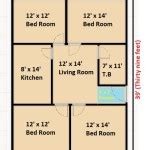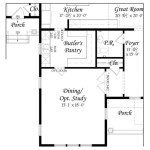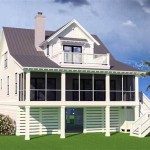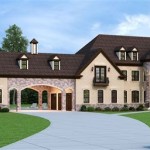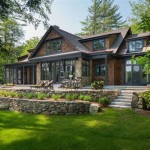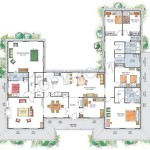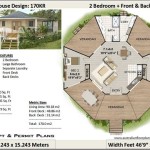4 Bedroom House Plan Low Cost: Designing for Affordability
Constructing a four-bedroom house can be a significant investment. However, with careful planning and strategic design choices, it is possible to create a functional and comfortable home without exceeding a reasonable budget. This article explores key considerations for developing a low-cost four-bedroom house plan, focusing on design principles, material selection, and construction techniques that can significantly reduce overall expenses.
Prioritizing Functionality Over Extravagance
The foundation of a low-cost house plan lies in prioritizing essential functions and minimizing unnecessary embellishments. This involves a critical evaluation of space requirements and a focus on efficient layouts that maximize usable area. Avoidance of complex architectural features, such as intricate rooflines, dramatic curves, or extensive ornamentation, is paramount. Simplicity in design translates directly into lower material costs and reduced labor time.
Begin by accurately determining the minimum space requirements for each room. Consider the typical activities that will occur in each area and design accordingly. For example, bedrooms should be sized to comfortably accommodate beds, storage, and a small workspace, if necessary. Living areas should provide adequate space for seating and entertainment, while kitchens should be functional and efficient for food preparation.
Open-concept floor plans can be particularly effective in low-cost designs. Combining the living room, dining area, and kitchen into a single, unified space reduces the need for walls and doors, thereby lowering construction costs. This also creates a more spacious and airy feel, which can be especially beneficial in smaller homes. However, careful consideration should be given to noise control and defining distinct zones within the open space.
Strategic placement of windows and doors is also crucial. Maximize natural light to reduce the need for artificial lighting, which can lower energy consumption and overall utility bills. Consider the orientation of the house to take advantage of solar gain in colder climates and minimize heat exposure in warmer climates. Proper ventilation is equally important for maintaining a comfortable indoor environment and reducing the risk of moisture buildup.
Furthermore, consider the placement of utilities, such as plumbing and electrical systems. Grouping bathrooms and kitchens together can simplify plumbing runs, reducing material costs and labor time. Similarly, strategically locating the electrical panel near the major appliances can minimize the amount of wiring required.
Strategic Material Selection to Minimize Costs
The selection of building materials is a major determinant of overall construction costs. Choosing affordable and readily available materials can significantly reduce expenses without compromising structural integrity or aesthetic appeal. Value engineering, a process of analyzing the cost-effectiveness of different materials and methods, is essential in developing a low-cost house plan.
Consider using cost-effective framing materials, such as engineered lumber or wood alternatives, which can offer comparable strength and durability to traditional solid wood at a lower price. Pre-fabricated components, such as trusses and wall panels, can also save time and labor costs during construction.
For exterior cladding, options like vinyl siding, fiber cement siding, or engineered wood siding offer durability and aesthetic appeal at a relatively low cost. Brick or stone veneer can be used sparingly as an accent feature to enhance the visual appeal without incurring the high cost of a full brick or stone façade.
Interior finishes should also be selected with cost in mind. Consider using laminate flooring or vinyl flooring as alternatives to hardwood or tile. These materials are durable, easy to maintain, and significantly less expensive. For walls, drywall is a standard and affordable option, but explore paint colors and textures to add visual interest. Minimize the use of expensive trims and moldings, opting for simpler and more economical designs.
In the kitchen and bathrooms, choose affordable cabinets, countertops, and fixtures. Look for standard sizes and styles to avoid custom fabrication costs. Consider using stock cabinets with laminate countertops and basic faucets and showerheads. These functional choices can significantly reduce the overall cost without sacrificing usability.
Explore salvaged or recycled materials, which can often be obtained at a fraction of the cost of new materials. Demolition sites and salvage yards can be sources for reclaimed lumber, bricks, doors, windows, and fixtures. However, be sure to carefully inspect these materials for structural integrity and safety before using them in construction.
Optimizing Construction Techniques for Cost Efficiency
The chosen construction techniques also play a vital role in determining the overall cost of a house. Utilizing efficient and streamlined construction methods can significantly reduce labor time and material waste, leading to substantial savings. A well-planned and executed construction process is crucial for maintaining budget control.
Consider using modular construction techniques, in which sections of the house are pre-fabricated in a factory and then assembled on-site. This approach can significantly reduce construction time and labor costs, as well as improve quality control. While modular construction may require a larger upfront investment, the overall savings can be substantial.
Simple and straightforward construction details are also essential. Avoid complex joinery or intricate framing techniques that require specialized skills and additional labor time. Opt for standard building practices that are familiar to most contractors and that minimize the risk of errors or delays.
Effective waste management is also crucial for minimizing costs. Develop a plan for recycling or reusing construction waste, such as lumber scraps, drywall offcuts, and packaging materials. This can reduce landfill fees and minimize the need for purchasing new materials. Careful planning and accurate material estimates can also help to reduce waste in the first place.
Consider incorporating energy-efficient construction techniques, such as improved insulation, airtight sealing, and high-efficiency windows and doors. While these upgrades may require a slightly higher initial investment, they can significantly reduce energy consumption and lower utility bills over the long term, resulting in substantial savings. Proper insulation also helps to maintain a comfortable indoor environment, reducing the need for excessive heating or cooling.
Finally, select a reliable and experienced contractor who is committed to working within your budget. Obtain multiple bids from different contractors and carefully review their qualifications and references. A good contractor will be able to provide valuable advice on cost-saving strategies and manage the construction process efficiently.
Remember to obtain all necessary building permits and comply with local building codes. Failure to do so can result in costly fines and delays, ultimately increasing the overall cost of the project. Work closely with the building inspector to ensure that the construction meets all applicable standards.
By carefully considering these factors and making informed decisions, it is possible to design and build a four-bedroom house that meets your needs and fits within your budget. A focus on functionality, strategic material selection, and efficient construction techniques are key to achieving a low-cost yet comfortable and livable home.
Thorough planning and diligent execution are crucial for success. This includes creating a detailed budget, developing a comprehensive set of construction documents, and closely monitoring the progress of the project. Effective communication with the contractor and other stakeholders is also essential for ensuring that the project stays on track and within budget.
Ultimately, a low-cost house plan is not about sacrificing quality or functionality; it is about making smart choices and prioritizing essential elements to create a home that is both affordable and comfortable for you and your family.

4 Bedroom Small Plot Home Design With Free Plan

Budget Friendly 4 Bed House Plan 55150br Architectural Designs Plans

Cost Effective 4 Bedroom Modern Home In Low Budget Free Plan

4 Bedroom House Plan In Village Bhk Home Plans Simple Low Budget

Building On The Affordable House Plans Of 2024 Houseplans Blog Com

4 Bedroom House Plan Examples

Est House Plans To Build Simple With Style Blog Eplans Com

House Design Plan 12x9 5m With 4 Bedrooms Home Ideas 9bc

New 4 Bedroom House Plans In Kenya 0718552405

Low Budget Simple House Design Plans For Builders Blog Builderhouseplans Com
Related Posts

